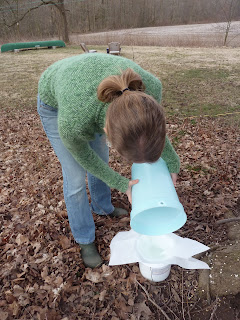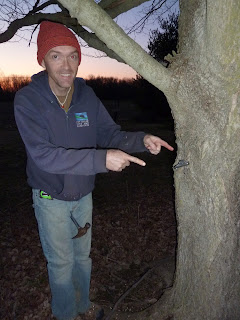So the maple sugaring story continues. This is a learning experience for us and nothing proved that more than cooking down the sap. We first tried cooking sap on an old salvaged Coleman Stove. (The woodstove you see in the barn is not yet hooked up.) We found out quickly the little stove was not up to the task when it wouldn't stay lit.
Take 2: Our grill! Our maple sugaring book lists grills as a potential good method for cooking down sap and we tried it in the very airy barn due to inclement weather.
The sap did boil and begin to evaporate....
ever so slowly. So how about some tea and treats while we wait?
In fact, why don't we tear off a barn wall and prepare it for siding?
Might as well jack up the building so when we frame the east end in, it is fairly square.
Yeh, and that's how it continued till very late at night. The grill method works, but on our tiny grill it is so so so slow.
The next day presented sunshine and really balmy February temps so we tried Take 3: cooking sap on our outdoor fire pit. First, we created a good hot coal base....
then, using what we had: an oven rack, a large stockpot leftover from Steve's beer making days and our canner, we crafted an outdoor stove.
The sap heated pretty quickly...
and started a steady, strong evaporation. Yay!
We cooked down 10 gallons on the outdoor firepit in about 10 hours. Still long, yes - but the extreme wind diffusing the heat did not help speed the process nor did our deep cooking pots. Lessons learned!
We did take time to enjoy the beautiful day and all the nature surrounding us...
After our main evaporation outdoors, we brought the super sweet liquid indoors to finish cooking. At all stages, the sap is delicious! I read many Natives would drink the sap raw though today we are cautioned against it for bacterial reasons. We are still fine. :)
Once the sap turned into syrup (we judged by stickiness to the spoon and level of foam on top; you can also use a candy thermometer to tell you when the temperature is 7 degrees F above the boiling point of water depending on where you live), we ran the syrup through a filter to separate most of the sediments.
Once the syrup starts to thicken as it cools it gets slower and slower so some assistance is necessary. We reheated once to thin it back down as well.
Look at that beautiful syrup!
We are freezing all the BPA free blue Ball plastic containers for use throughout the year. The glass jar is in our refrigerator for immediate consumption. The syrup really is incredibly delicious. There is just something in the flavor that indicates it came from our sugar maples, direct to our kitchen and into our bellies. There's nothing like it!
Stats so far: ~20 gallons of sap collected, ~112 ounces of syrup (almost a gallon!)
Oh, did we mention the sap is still flowing?!
Wednesday, February 29, 2012
Thursday, February 23, 2012
Maple Sugaring: Part II
After tapping the maple trees, the real work begins. We are collecting sap this week with plans to cook down this weekend.
We run the collected sap through a filter to collect any debris or insects that were attracted to the sweetness.
Here's a look at the sap:
It looks like water and it mostly is at this stage though we've noticed the liquid is a bit sticky.
We started with these little food grade buckets because we had them left over from other projects, but we purchased two 5 gallon BPA-free water jugs to offer us our more storage capacity. After we collect today we will have about 15 gallons to boil down! More soon.
We run the collected sap through a filter to collect any debris or insects that were attracted to the sweetness.
Here's a look at the sap:
It looks like water and it mostly is at this stage though we've noticed the liquid is a bit sticky.
We started with these little food grade buckets because we had them left over from other projects, but we purchased two 5 gallon BPA-free water jugs to offer us our more storage capacity. After we collect today we will have about 15 gallons to boil down! More soon.
Friday, February 17, 2012
Maple Sugaring Time (A first for us!)
We have 3 good size sugar maples west of our house and we decided to tap them this year to try our hand at making syrup.
We followed directions:
drilled a 7/16" hole into the south side of our tree (this felt wrong!) at a slight upward angle so sap will run out...
checked the wood shavings to make sure they looked healthy and not rotten....
laughed happily when the sap started dripping out immediately...
tapped the spile in gently with a hammer....
hung our Canada made buckets....
put the lids on to keep the critters out....
and admired our 10 minutes of effort! We know the real time commitment comes with cooking the sap down. More on that as we progress!
We followed directions:
drilled a 7/16" hole into the south side of our tree (this felt wrong!) at a slight upward angle so sap will run out...
checked the wood shavings to make sure they looked healthy and not rotten....
laughed happily when the sap started dripping out immediately...
tapped the spile in gently with a hammer....
hung our Canada made buckets....
put the lids on to keep the critters out....
and admired our 10 minutes of effort! We know the real time commitment comes with cooking the sap down. More on that as we progress!
Thursday, February 16, 2012
Finally, More Soap!
New recipes, scents and wrapper plus a switch to organic, certified sustainable palm oil makes for great progress! It's so exciting to finally dedicate more time to soap making. Four batches are cured and listed on our Etsy site, at least 3 more are on the agenda for the next 2 weeks.
Piles of soap make me very happy....
We work to make our product good for us and good for the Earth!
If you want to purchase soap outside of Etsy, just message us and we will arrange an order.
More soapy goodness soon!
Piles of soap make me very happy....
We work to make our product good for us and good for the Earth!
If you want to purchase soap outside of Etsy, just message us and we will arrange an order.
More soapy goodness soon!
Monday, February 13, 2012
The "Reclaim Your Life's Hours from the Abyss" Towel Hanger
Yesterday I (Steve) spent several hours making a map of our house's electrical circuits in preparation for some remodeling projects. The sketch below illustrates the haphazard nature of this old house's electrical system. As I was making this map I could feel my life's hour's slowly draining into some sort of abyss. Not that this sort of thing is not fun (it's a bit of a puzzle, in fact) - it's just that one cannot do it all so.....
...the next day I decided to switch gears and grab some colorful tiles we got at an antique shop plus....
The door knobs were then conveniently screwed onto their original shank:
I used a couple of appropriately-sized spacers to lay out the position of tiles and then...
....applied some adhesive and then....
...affixed the tiles onto the backer board.
...the next day I decided to switch gears and grab some colorful tiles we got at an antique shop plus....
...some old barn wood that I got from a barn in NE Indiana plus...
...some old doorknobs that we got somewhere for free. The goal was to make a towel hanger for an upcoming bathroom remodel the theme of which will be "festive".
The door knobs would be the actual hangers for the towels but the hardware first needed altered. Amazing what you can do with a vice and some hand tools (hacksaw and file):
What's the point of this? Wait for it...
The old barn siding board that I'd intended to use for the backer already had an angle cut on one end so I decided to replicate that angle on the other end. Lest ye shudder in anticipation of the use of trigonometry - fear not - a simple adjustable angle gauge suffices for a lot of things. Just get the angle you want and...
...transpose it to one you want to cut and...
...mark it, then....
...replicate the angle on your table saw and cut the darn thing (being careful to not cut your fingers off)!
The hardware from step 1 was then glued/driven into the backer board:
The door knobs were then conveniently screwed onto their original shank:
I used a couple of appropriately-sized spacers to lay out the position of tiles and then...
....applied some adhesive and then....
...affixed the tiles onto the backer board.
Does it meet the "festive" criterion?
A closer look:
Jennifer appears to indicate that festive-ness was achieved!
Getting a start on laying out some funky and festive pieces for our planned half-bath. This bathroom is going to be a riot of color with a healthy splash of simplicity!
































































